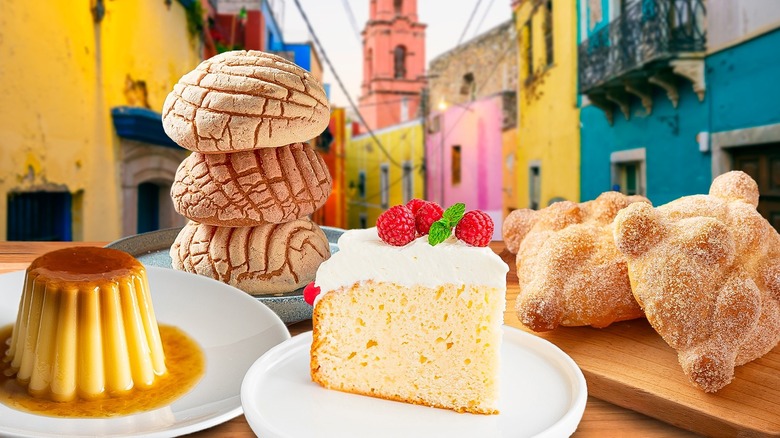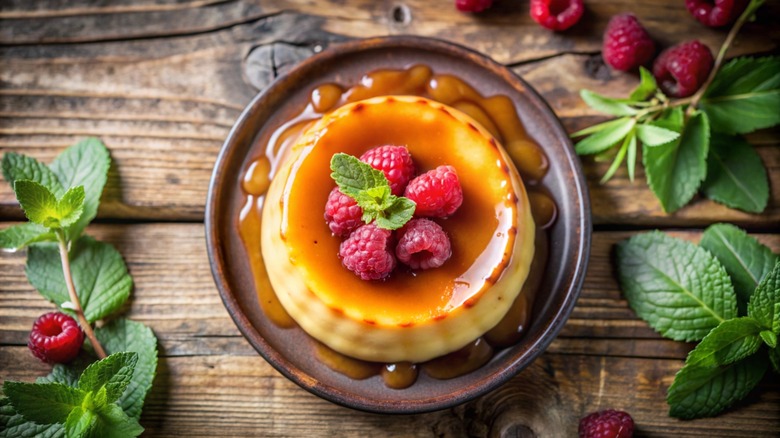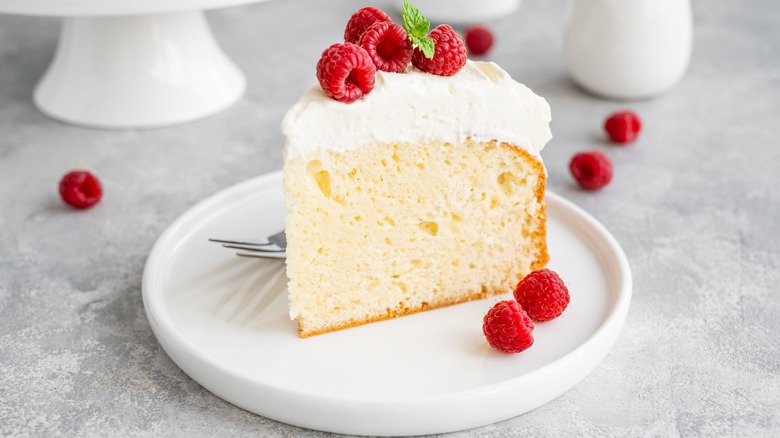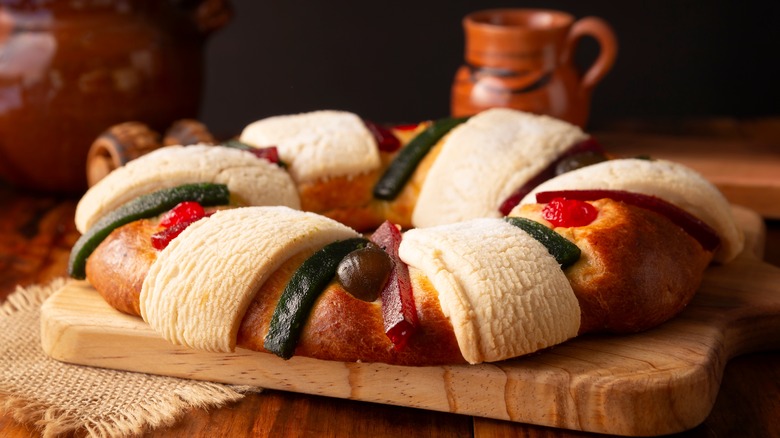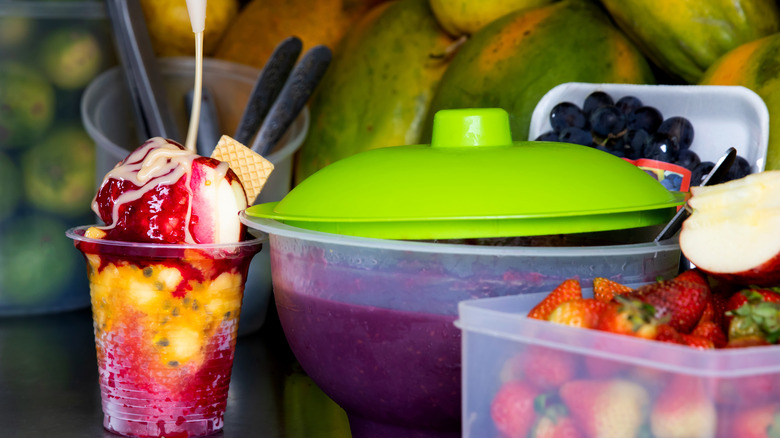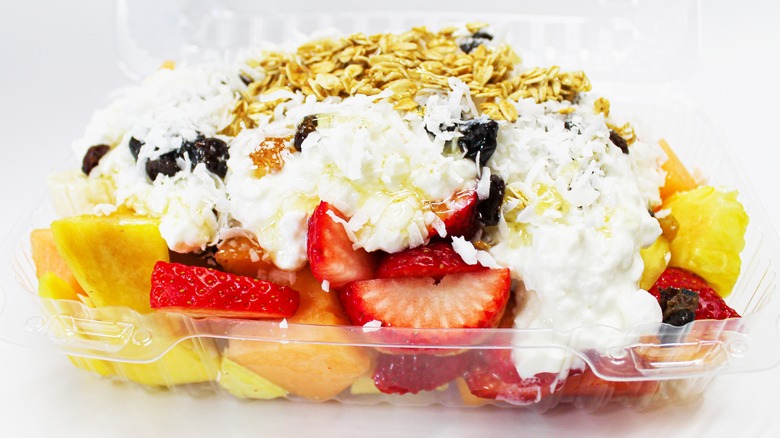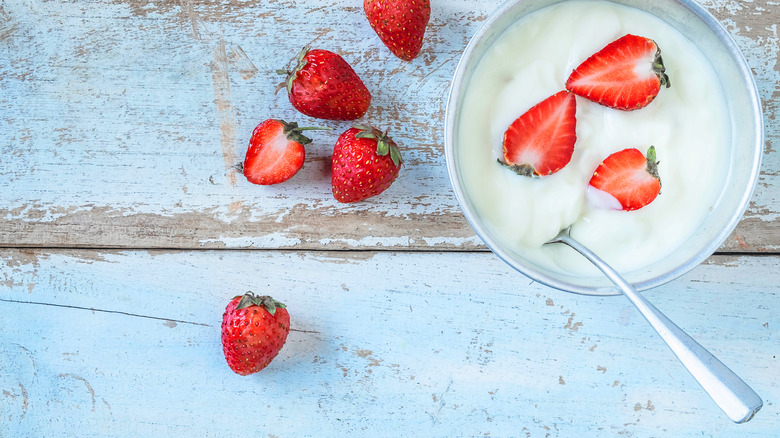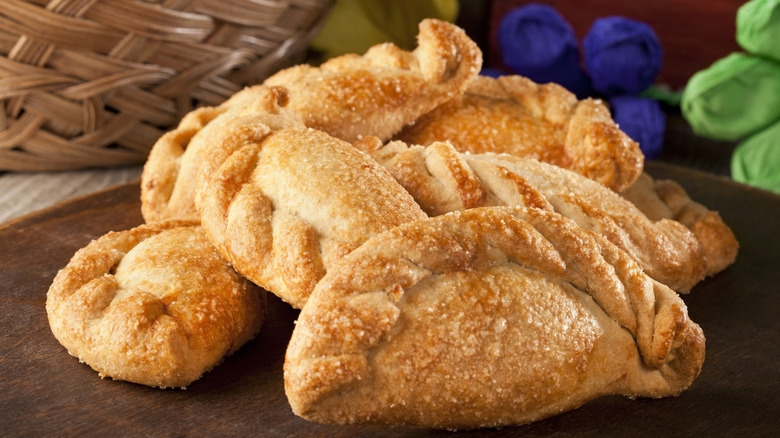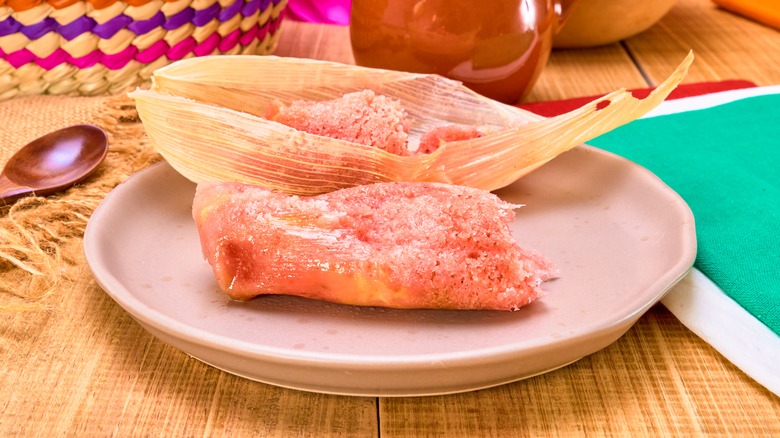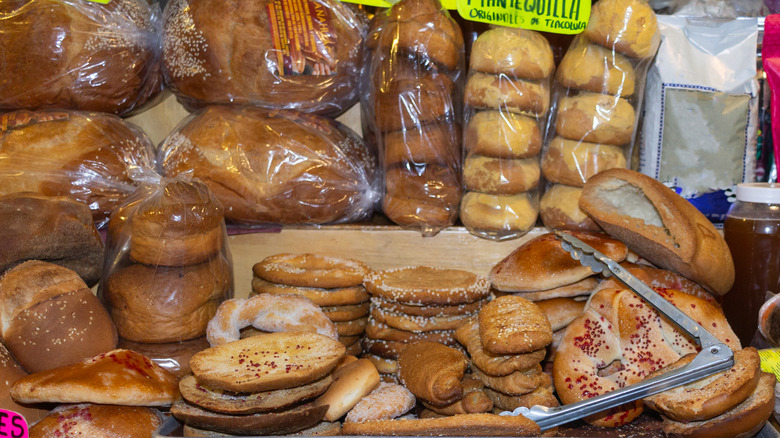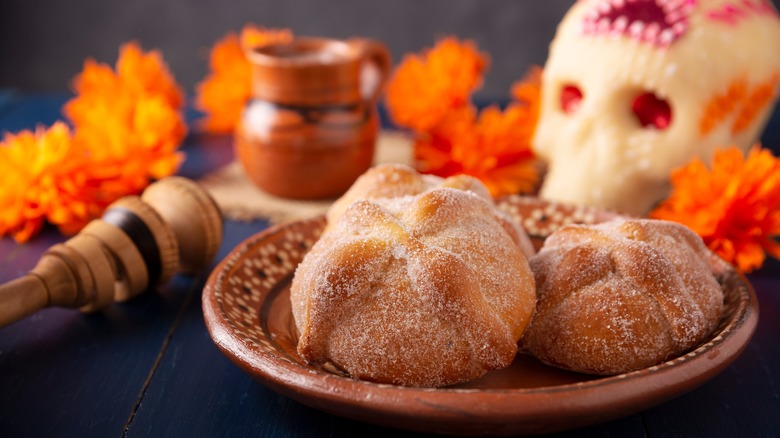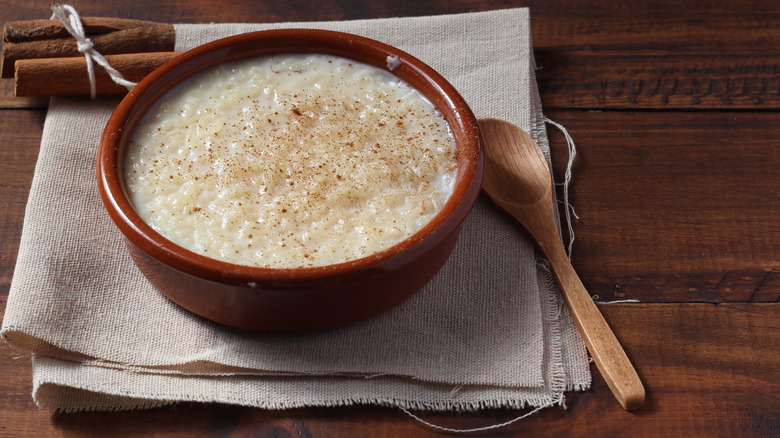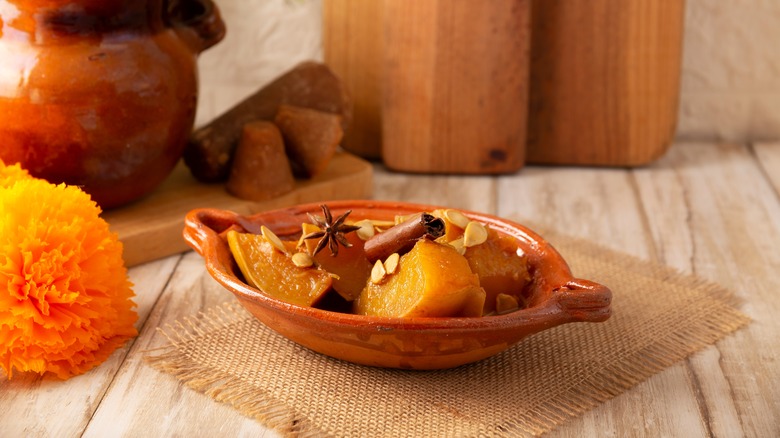12 Classic Mexican Desserts You Need To Try At Least Once
Mexican cuisine is known and loved by many in the United States, with an abundance of sit-down restaurants and fast food drive-thrus all over the country. Whether you're eating something purely traditional or with an Americanized Tex-Mex twist, most people could probably pick their favorite dish if asked — and some even have a cult following (for example, Taco Bell's Crunchwrap Supreme). While the savory foods that hail from Mexico and its surrounding regions are to die for, the desserts are in a league all of their own. From cakes to custards, breads, and pastries, there are limitless options that could satisfy even the pickiest of eaters at any time of day, all throughout the year.
In addition to my own experience as a professional baker and recipe developer, I spoke with chef Wes Avila of MXO Steakhouse in Los Angeles, whose expertise will allow us to gain further insight into sweet Mexican dishes that need no introduction, as well as some that people outside of Mexican communities may not have heard of before. These are the classic Mexican desserts you should save some room for.
1. Flan and chocoflan
Probably one of the most iconic and well-known Mexican desserts, flan is not only found at many celebrations, but as chef Wes Avila says, "It's also a street food in certain districts of Mexico, making it very accessible for even everyday consumption." Flan is a custard that is flipped upside down after baking to allow the caramelized bottom to fall over and coat the rest of the cake.
That being said, the caramel was not always a part of this once-savory dish, which originated in Ancient Rome. It wasn't until the Spanish decided to add sugar to the base that flan became the classic dessert we know and love today. "Flan can be difficult to mastering as the texture and caramel are only achieved through patience and meticulous technique," Avila notes.
However, even more complex is chocoflan, a layered combination of the classic flan with chocolate cake, which Avila explains is also known as the Impossible Cake due to the baking techniques required to achieve this dessert. The rich custard paired with the decadent chocolate makes for a flavor combination that's out of this world. During the baking process, the layers of the chocolate cake batter topped with the custard invert, and when flipped out of the pan, become enveloped in a sweet caramel coating. Though the origins of chocoflan are contested, this staple Mexican dessert is one you don't want to miss out on.
2. Tres leches
Tres leches, or three milks, is arguably one of the moistest cakes you will find in any cuisine. Made by adding a combination of whole milk, evaporated milk, and sweetened condensed milk to a basic vanilla sponge cake, tres leches is often topped with either whipped cream or meringue and various fruits. Much like chocoflan, the origins of tres leches are unclear; however, its popularity can likely be tied to the commercialization of canned milk products, as well as American imperialism pushing their production to countries like Mexico and Nicaragua.
While a classic tres leches cake uses predominantly vanilla flavorings, there are a world of possibilities and variations that one can come up with. For a richer and more decadent tres leches, starting with a chocolate sponge cake as opposed to vanilla balances out the sweetness of the milk. For something fresher and more summery, a lemon tres leches cake has just enough zing to balance out the heaviness of the dense cake. Regardless of whether or not you go for something more traditional or something with a twist, there is basically no way to be disappointed by a piece of tres leches cake.
3. Rosca de reyes
Also known as three kings cake, rosca de reyes is served for the January 6th holiday Día de Reyes, or Three Kings Day, celebrating the three wise men. Traditionally, a small plastic baby figurine representing baby Jesus is hidden in the cake. Chef Wes Avila notes that the person who finds it in their slice has to throw a party for the other guests, saying, "It is a fun family tradition that we partake in every year."
While some may recognize this tradition as the king cake served in New Orleans on Fat Tuesday, which similarly features the plastic baby Jesus, the cakes are actually quite different. Though they both celebrate similar things and are baked in the shape of a ring, rosca de reyes is a sweet and colorful bread often flavored with orange and decorated with dried fruits like quince, guava or figs, and candied maraschino cherries to represent the gifts brought to baby Jesus by the three kings.
If you've tried the Mardi Gras king cake, the Día de Reyes cake is more subtle in its sweetness and subdued in color — but the taste is still out of this world. Up the decadence by enjoying a slice of this Mexican treat with hot chocolate.
4. Raspado
Not all Mexican desserts are something that can be baked in an oven. Raspado is a type of shaved ice that is a popular street food in Mexico. "The shaved ice is topped with syrups that are made with seasonal fruit, which makes it so refreshing," chef Wes Avila says. One popular addition that takes this refreshing treat from good to great is sweetened condensed milk, which turns this icy dessert into something creamy. For a spicy, zingy twist, some people like to add chamoy, a peppery sauce made from pickled fruits. Adding this mildly savory element to a usually sweet dessert is a fun, unique play on a classic and one many people enjoy.
If you're looking to try it for yourself, shaved ice vendors can be found in shops all around the United States in standalone businesses or food trucks that specialize in this fruity treat. Regardless of what fruits or toppings you try, you're bound to want to come back for seconds.
5. Bionico
Largely underrepresented when discussing Mexican cuisine is bionico. A type of fruit salad, it's also one of chef Wes Avila's favorites. "It is a very humble dessert that contains fresh fruit, vanilla, plain yogurt, granola, and dried coconut sweetened with condensed milk," he says. "Whenever I have bionico, it always transports me back to the best memories of my childhood."
Despite this nostalgia factor, however, Avila notes that this classic Mexican dessert is unfortunately rarely seen on menus at Mexican restaurants in the U.S. So, unless you're willing to find a street vendor in Mexico, bionico is a treat that can luckily easily made in the comfort of your own home. Though the types of fruits used in this sweet salad may vary, it's typically comprised of cubes of papaya, bananas, strawberries, cantaloupe, and apples. Once you whip up a bowl of bionico for yourself, you'll be sure to be wanting more.
6. Fresas con crema
Arguably one of the easiest desserts to make at home is fresas con crema, according to chef Wes Avila. "All home cooks would need is fresh strawberries, condensed milk, vanilla, and sour cream," he says, adding, "We normally consume it at street fairs, which brings back memories of summer nights." Although it seems simple, this quick-to-assemble, no-bake dish is one with great depth of flavor. The tart strawberries, grown in abundance in Mexico, paired with the sweet milk and tangy sour cream explain why this dish is so popular in regions across the country.
If you're looking to try this authentic treat without making it yourself, you can buy it fresh from sweet shops or street vendors or purchase single-serving cups in the refrigerated section of a local Mexican grocer. While this dessert is typically served on its own, you can also use it to freshen up savory dishes like fish, salad, or grilled chicken. Regardless of where you try this or if you make it on your own, the use of the most ripe, sweet strawberries is imperative to perfecting this classic Mexican dish.
7. Empanadas de fruta
Although most people recognize empanadas as a savory dish, the filling possibilities for these pockets of dough are endless, and a classic Mexican dessert is empanadas de fruta. Whether you find these at a local Mexican restaurant or your nearest panadería (or, Mexican bakery), you're likely to fall in love with these baked or fried little turnovers. "Panadería's always bake their breads and desserts daily to ensure that customers receive the freshest product possible," chef Wes Avila says. "And I love that they serve the pastries warm, ready to be enjoyed right then and there."
Depending on the season you have empanadas de fruta, you can expect to find different types of fillings — though a popular combination is the classic guava and cream cheese empanada. Likely something that originated in Miami from Cuban immigrants, this flavor combo is prevalent in Latin baking all over the world. An alternate variation includes the use of the Mexican cream guava, which is slightly sweeter than its counterparts. However, if a fruit-and-cheese flavor pairing isn't your cup of tea, plain fruit fillings like strawberries, apples, and peaches will still win over any crowd.
8. Sweet tamales
Much like empanadas, tamales are often recognized as a savory dish. Typically made with masa, wrapped in a corn husk or banana leaf, and seasoned with meats and cheeses, there's no rule saying you can't make variations of tamales that are sweet. Noting the versatility of tamales, chef Wes Avila states that he's made dessert versions of them with fruits, jams, and sometimes chocolate as a play on this classic dish.
Tamales themselves have been around for thousands of years, dating back to the ancient Aztec and Maya populations in Mesoamerica. However, sweet tamales later made their introduction when Spanish conquistadors brought sugar and spices to Mexico in the 16th century. As a result, sweet tamales — often with colorful corn husk wrappers — are commonly found being sold by street vendors all across Mexico, especially during various holidays throughout the year. If you're not able to get them directly from Mexico, you can still try sweet tamales yourself at Mexican bakeries or specialty stores. Whether you try ones flavored with fruit, dulce de leche, chocolate, or cinnamon and sugar, they are bound to satisfy anyone's sweet tooth.
9. Pan dulces
A staple of Mexican cuisine is something referred to as pan dulces, or sweet breads, which cover a myriad of different desserts and pastries sold year-round in panaderías. While many of these can be made in the comfort of your own home or purchased in grocery stores, nothing compares to the sweet smell (and taste!) of fresh pan dulces when you walk into a panadería. Arguably the most recognizable are conchas, a sweet bun topped with a crackled, shell-shaped crust. They can be served alone or alongside some hot chocolate; and while conchas are typically unflavored, that hasn't stopped modern bakers from experimenting by adding vanilla, chocolate, spices, or fruit spreads.
If you're looking for something lighter and fluffier with a crunchier coating, look no further than the chilindrina — another type of sweet bread bun that's egg-based and topped with crystal sugar. Bisquets, easily identifiable by the circular depression on its top, are a yeasted pan dulce influenced by classic American biscuits. However, the preparation takes longer, the taste is sweeter, and the appearance slightly differs, with many recipes requiring the top to be painted with an egg wash and topped with sugar to give it a sweet, crispy crust. Bisquets are best enjoyed plain or topped with preserves or butter to balance out the sweet flavors.
The cutest form of pan dulce is pig-shaped marranitos. Despite their classification as Mexican "gingerbread," there's often no ginger to be found in these treats, though some modern recipes will include it. Instead, their color and flavor typically come from piloncillo or molasses. Orejas are a type of sweet bread made of puff pastry and dusted with cinnamon and sugar. Sometimes referred to as palmiers or elephant ears, these crispy, buttery, flaky, palm-shaped treats are simple but always a crowd-pleaser. Lastly, shaped just like a mustache and topped with sugar, bigotes are similar to a croissant and crescent roll combination. Baking them may be time-consuming if you try to do it yourself, but any panadería worth its salt will already be carrying them for you to try fresh.
10. Pan de muertos
Another type of sweet bread, or pan dulce, that's eaten specifically for Día de los Muertos is called pan de muertos — which translates to "dead bread." You can purchase this sweet, yeasted, orange-glazed bread at any panadería or Mexican grocery store in the weeks leading up to the Day of the Dead on the first of November. One of the classic features of this treat that sets it apart from any others is that these round buns are often adorned with an X made with additional dough that is said to represent a skull and crossbones.
Because this holiday is meant to honor friends and family members who have passed on, pan de muertos is typically consumed either at the gravesites of loved ones or at ofrendas, altars to the deceased that are usually set up in one's home. Even if the Day of the Dead isn't a holiday you're used to celebrating, partaking in the consumption of pan de muertos is not only a great way to try a tasty treat from another culture, but to also honor loved ones in ways you may not have before.
11. Arroz con leche
Arroz con leche, which translates to rice with milk, is a sweet Mexican rice pudding dish typically served during the holidays, chef Wes Avila tells us — though many also enjoy it year-round. Often topped with cinnamon or served with cinnamon sticks, arroz con leche is a relatively simple dish that really packs a punch. While the name suggests the recipe is made with only two ingredients, rice and milk, some bakers prefer to use sweetened condensed milk or evaporated milk over the standard whole milk while others use a combination of all three.
Regardless, this well-known classic can be found not only at Mexican restaurants but in grocery stores all over the United States. There's no telling which brand makes it best or who will satisfy your craving more than others, but once you find the packaging that's in Spanish, you'll know you've found the right one. If you prefer to make it at home for yourself, friends, or family, these simple ingredients will come together to make the perfect creamy sweet treat.
12. Calabaza en tacha
Candied pumpkin, which is a dessert referred to as calabaza en tacha, is another traditional Mexican treat. Similarly to arroz con leche, chef Wes Avila says of calabaza en tacha, "Both desserts draw inspiration from seasonal ingredients and spices that create that warm, cozy feeling we like for the holidays." In addition to Thanksgiving and Christmas, this dessert is typically served in celebration of Día de los Muertos, much like pan de muertos, when pumpkins are abundant. Because this gourd has been cultivated in Mexico for millennia, it's no surprise this dish is so popular.
While variations of calabaza en tacha can be found in different regions of Mexico, the main ingredients are usually comprised of pumpkin, cinnamon, and piloncillo syrup, a type of sugar cane usually sold in Mexican grocery stores that's packed in dense cones. In order to make this candied treat, the pumpkin needs to first be broken down into small pieces before being boiled in water with all the other ingredients. When the pumpkin is fully cooked, the remaining ingredients cook down into a thick, sweet syrup that is drizzled over the pieces of squash.
Much like pan de muertos, when enjoyed on the Day of the Dead, this dessert is one that is not only shared by the living but offered to the dead at in-home altars. Regardless of what time in your life you try it, calabaza en tacha has a flavor that will be remembered for a lifetime.
